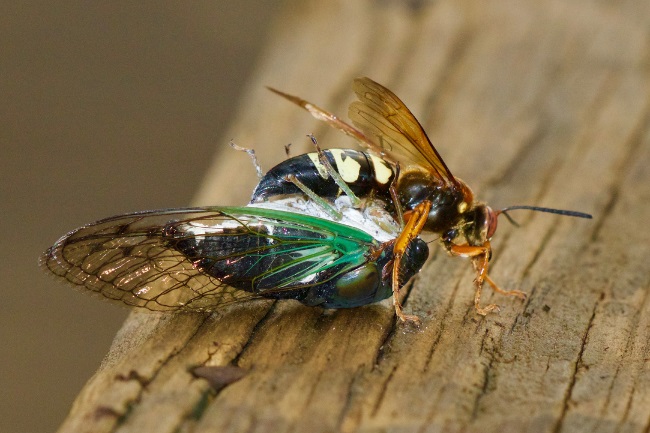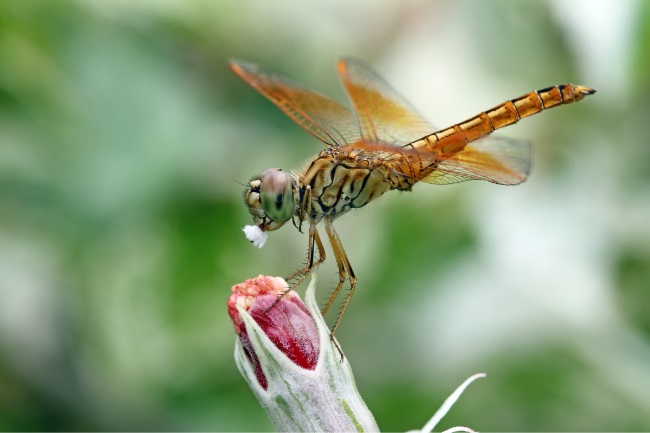Dragonflies are consumers, as they do not get their energy directly from the sun and they do not break down plant waste. Due to their diet of smaller insects, they would generally be considered secondary or tertiary consumers.
Contents
What is the food web?

The food web describes the movement of energy from one lifeform to another through consumption. These food webs can often be highly complex, however, when broken down they are made up of producers, consumers and decomposers.
| Feeding Hierarchy | Description |
|---|---|
| Primary Consumer | Dragonfly nymphs are considered primary consumers as they feed on small aquatic invertebrates and other small organisms. |
| Secondary Consumer | Adult dragonflies are considered secondary consumers as they primarily feed on other insects, such as mosquitoes, flies, and small flying insects. |
Also read: What Eats Dragonflies? (A List of its Enemies)
What is a producer?
A producer is always the first living being in a food web. These are those that produce their own food by taking energy directly from the sun (or potentially other sources such as hydrothermal vents). This means that producers are generally plants. Producers could be algae within a pond, or trees within a forest.
What is a consumer?
A consumer is a creature that gets its energy by feeding on either producers or other consumers. Primary consumers are those that eat producers. These would be herbivores, as these are animals that eat only plant matter. For example, cows and giraffes are primary consumers feeding on grasses or other plant matter such as the leaves of trees.
Secondary consumers eat the primary consumers. These are animals that eat herbivores, making them carnivores if they eat only meat, or potentially omnivores, those who eat both meat and plant matter. A fox would be an example of a secondary consumer, eating rabbits, who are primary consumers eating grass.
Tertiary consumers are those that eat the secondary consumers, making them also omnivores or carnivores. An example of this could be a polar bear, eating a seal that is a secondary consumer eating a primary consumer such as a fish.
What is a decomposer?
A decomposer is a living creature that breaks down dead matter. Fungi and bacteria are examples of this. Decomposers are important for providing food for producers and getting rid of waste.
What is a dragonfly?

Dragonflies sit within the consumer category, as they neither break down dead matter nor take their energy directly from the sun. Within the consumers, they would be considered a secondary or tertiary consumer.
This is because they are carnivores, meaning they cannot be a primary consumer. However, depending on what they eat they may be feeding on a secondary consumer, such as an aphid that has been feeding on plants, or on mosquitos that have been feeding on the blood of other animals.
Dragonflies feed on a large range of small insects, both flying insects such as butterflies, and even those that spend their time on the ground like ants. As larvae they live underwater, meaning their diet is composed largely of aquatic invertebrates, however, they also attempt larger prey when possible, such as small fish and tadpoles.
Also read: What Does a Dragonfly Eat and Drink? (Habits Explained)
Is it really that simple?
While the categories of producer, consumer and decomposer, may be wonderfully simple and easy to follow, the truth is the food web is much more complex even than this. Nature does not like fitting within small and easy to define boxes.
Most notably some plants are carnivorous, meaning they do not fit neatly into the producer category, though they still get their energy from the sun. The Venus flytrap, for example, closes its leaves around tasty flies to supplement its poor diet from living in nutrient-poor bogs.
Mushrooms too aren’t always passive decomposers. Oyster mushrooms have been found to ensnare nematodes in underground lassos, adding them to the other tasty morsels they are busy decomposing underground.
A link in the chain
Dragonflies are both consumers themselves and are likely to be consumed by other animals. Birds, spiders and even other dragonflies will happily munch down on a dragonfly when given the chance. The complex interactions between these various species is what makes the food web a fascinating tangle of different threads, more dynamic than we can ever understand.

